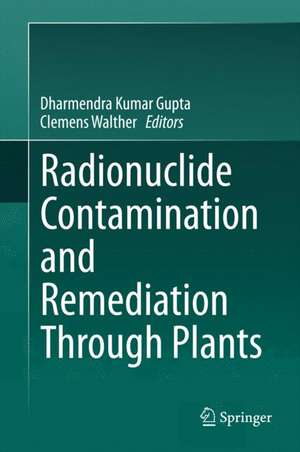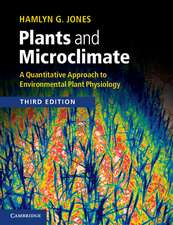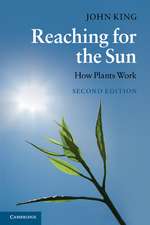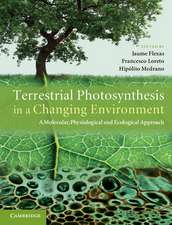Radionuclide Contamination and Remediation Through Plants
Editat de Dharmendra Kumar Gupta, Clemens Waltheren Limba Engleză Hardback – 30 iul 2014
Radionuclide contaminants pose serious problems for biological systems, due to their chemical toxicity and radiological effects. The processes by which radionuclides can be incorporated into vegetation can either originate from activity interception by external plant surfaces (either directly from the atmosphere or from resuspended material), or through uptake of radionuclides via the root system. Subsequent transfer of toxic elements to the human food chain is a concrete danger. Therefore, the molecular mechanisms and genetic basis of transport into and within plants needs to be understood for two reasons: The effectiveness of radionuclide uptake into crop plants – so-called transfer coefficient – is a prerequisite for the calculation of dose due to the food path. On the other hand, efficient radionuclide transfer into plants can be made use of for decontamination of land – so-called phytoremediation, the direct use of living, green plants for in situ removal of pollutants from the environment or to reduce their concentrations to harmless levels.
Toate formatele și edițiile
| Toate formatele și edițiile | Preț | Express |
|---|---|---|
| Paperback (1) | 945.92 lei 6-8 săpt. | |
| Springer International Publishing – 23 aug 2016 | 945.92 lei 6-8 săpt. | |
| Hardback (1) | 797.09 lei 38-45 zile | |
| Springer International Publishing – 30 iul 2014 | 797.09 lei 38-45 zile |
Preț: 797.09 lei
Preț vechi: 1048.79 lei
-24% Nou
Puncte Express: 1196
Preț estimativ în valută:
152.52€ • 159.24$ • 126.23£
152.52€ • 159.24$ • 126.23£
Carte tipărită la comandă
Livrare economică 31 martie-07 aprilie
Preluare comenzi: 021 569.72.76
Specificații
ISBN-13: 9783319076645
ISBN-10: 3319076647
Pagini: 314
Ilustrații: X, 314 p. 49 illus., 20 illus. in color.
Dimensiuni: 155 x 235 x 25 mm
Greutate: 0.63 kg
Ediția:2014
Editura: Springer International Publishing
Colecția Springer
Locul publicării:Cham, Switzerland
ISBN-10: 3319076647
Pagini: 314
Ilustrații: X, 314 p. 49 illus., 20 illus. in color.
Dimensiuni: 155 x 235 x 25 mm
Greutate: 0.63 kg
Ediția:2014
Editura: Springer International Publishing
Colecția Springer
Locul publicării:Cham, Switzerland
Public țintă
ResearchCuprins
Phytoremediation of Radionuclides: A Report on the State of the Art.- Natural Plant Selection for Radioactive Waste Remediation.- Radionuclide Uptake From Soil to Plants: Influence of Soil Classification.- Contributions to the State of the Art in Radionuclides-Plants Interaction Field.- Transfer of Radionuclides to Plants: Influence on the Speciation of Radionuclides in Soil.- Radionuclide Uptake by Plants: Soil to Plant Transfer Factors, Kinetics of Absorption and Internal Radionuclide Distribution of 137Cs And 40K in South American Species.- Impact on Plant Growth in Waste Contaminated Areas.- Remediation of Radionuclide Contaminated Sites Using Plant Litter Decomposition.- Bioaccumulation of Radionuclide Metals in Plants: A Case Study of Cesium.- Speciation of Actinides After Plant Uptake.- Kinetic Models for Representing the Uptake of Radionuclides in Plants.- Metal-Microbe Interaction and Bioremediation.- Metabolism of 14C-Containing Contaminants in Plants and Microorganisms.- 90Sr and 137Cs Accumulation in Plants in the Area of Radiation Accidents.- Migration of 90Sr and 137Cs in the Soil After Radiation Accidents.
Textul de pe ultima copertă
This book focuses on the mechanistic (microscopic) understanding of radionuclide uptake by plants in contaminated soils and potential use of phytoremediation. The key features concern radionuclide toxicity in plants, how the radioactive materials are absorbed by plants, and how the plants cope with the toxic responses. The respective chapters examine soil classification, natural plant selection, speciation of actinides, kinetic modeling, and case studies on cesium uptake after radiation accidents.
Radionuclide contaminants pose serious problems for biological systems, due to their chemical toxicity and radiological effects. The processes by which radionuclides can be incorporated into vegetation can either originate from activity interception by external plant surfaces (either directly from the atmosphere or from resuspended material), or through uptake of radionuclides via the root system. Subsequent transfer of toxic elements to the human food chain is a concrete danger. Therefore, the molecular mechanisms and genetic basis of transport into and within plants needs to be understood for two reasons: The effectiveness of radionuclide uptake into crop plants – so-called transfer coefficient – is a prerequisite for the calculation of dose due to the food path. On the other hand, efficient radionuclide transfer into plants can be made use of for decontamination of land – so-called phytoremediation, the direct use of living, green plants for in situ removal of pollutants from the environment or to reduce their concentrations to harmless levels.
Radionuclide contaminants pose serious problems for biological systems, due to their chemical toxicity and radiological effects. The processes by which radionuclides can be incorporated into vegetation can either originate from activity interception by external plant surfaces (either directly from the atmosphere or from resuspended material), or through uptake of radionuclides via the root system. Subsequent transfer of toxic elements to the human food chain is a concrete danger. Therefore, the molecular mechanisms and genetic basis of transport into and within plants needs to be understood for two reasons: The effectiveness of radionuclide uptake into crop plants – so-called transfer coefficient – is a prerequisite for the calculation of dose due to the food path. On the other hand, efficient radionuclide transfer into plants can be made use of for decontamination of land – so-called phytoremediation, the direct use of living, green plants for in situ removal of pollutants from the environment or to reduce their concentrations to harmless levels.
Caracteristici
Focuses on the mechanistic (microscopic) understanding of radionuclide uptake by plants in contaminated soils and potential use of phytoremediation State-of-the-art contents on radionuclide toxicity in plants With contributions by international experts Includes supplementary material: sn.pub/extras









